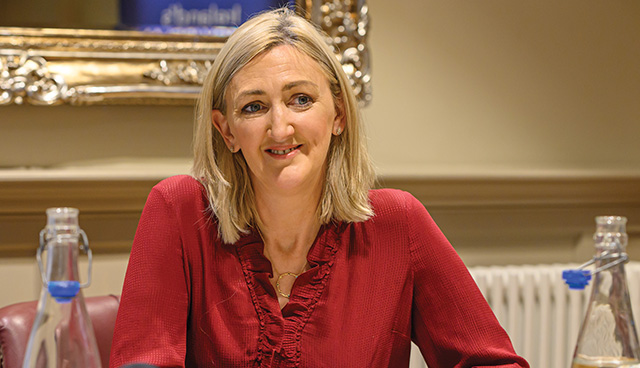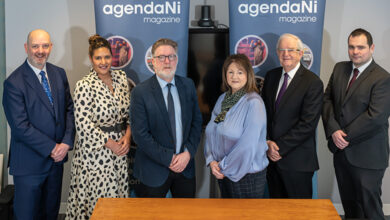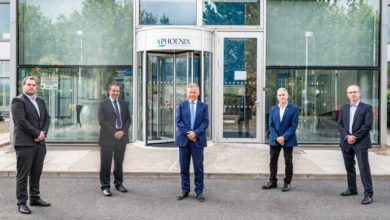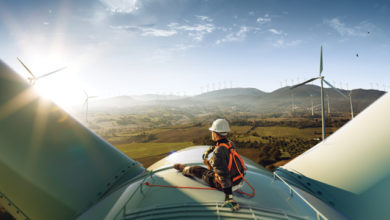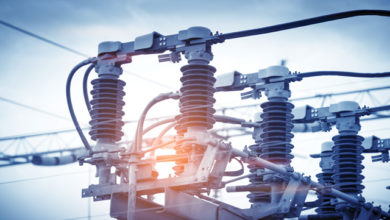Road-mapping a zero-carbon future for the North West
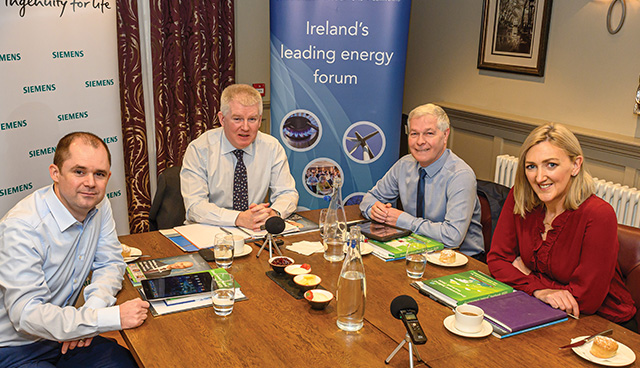
Siemens hosted a working lunch in Derry City on road-mapping a zero-carbon future for the North West region.
Leo, please outline the zero-carbon strategy for the North West.
Leo Strawbridge
This is a regional energy strategy for the North West region developed under the leadership of Derry City and Strabane District Council along with Donegal County Council. It is unique because it is cross-border. Both councils work together in other areas and this is an extension of that cooperation. We need an energy strategy for the whole of the North West rather than a strategy for each council area in order to benefit the region. We reviewed the current energy landscape, looking at the energy mix, current incentives, the technology available and the generation and delivery mechanisms for energy in the region. From this a strategy and a roadmap were developed with five main themes: smart energy management; renewable energy and battery storage; low carbon transport; low carbon heating; and energy efficiency. The roadmap itself has short-term and long-term goals. Out of this came nine key workstreams to establish a regional smart energy system for the North West. This transformation will be delivered through funding applications in partnership with local organisations and higher education establishments and through EU funded projects such as the Stardust project, a Smart City Region project and SMARCTIC, a Smart Rural Region project. Over the past couple of months, we have engaged with key groups to develop the strategy and help shape the final document. These groups included network operators, utility regulators, local universities and a number of multinational companies, including Siemens. One of the nine workstreams in the Smart Regional Energy System is digitalisation, data collection and smart energy control and this is where we believe Siemens can play a part in its development.
How did Siemens get involved in this initiative?
David McGaffey
As a company Siemens is totally committed to being carbon neutral by 2030 and of course we have many carbon reducing solutions for our customers. Together with other stakeholders, we were invited for an initial overview of the strategy and to discuss how best we could support the initiative. Our involvement to date has been driven by a desire to use our knowledge to assist in shaping the strategy with the ultimate goal to provide the solutions that achieve a carbon reduction in the North West region.
Joan Mulvihill
When people look at zero-carbon they tend to focus on energy creation and consumption, which is a core part of our business. However, zero-carbon needs a broader perspective and that’s where Siemens strengths in digitalisation come into play. For example, for industry in the region digitalisation can contribute greatly to reducing the carbon footprint of manufacturing sites, beyond the types of power they use but the levels of efficiency generally at which they operate. Zero-carbon spans everything we do, from major energy infrastructure projects to industry specific projects, domestic and public service initiatives.
What sectors of the economy need to be decarbonised? How do we achieve a low carbon economy and still have economic growth?
Joan Mulvihill
The strategy looks at three strands of energy use: domestic, industry and government. Getting to zero-carbon by 2045 is not just the challenge; it’s getting there while also driving economic growth in the region. There is a huge challenge in growing local industry whilst still getting to zero-carbon. In the domestic sector it’s not just about energy efficiency of the housing stock, but issues such as planning. Planning policy that consolidates development will lead to shorter travel distance requirements and lower energy use in transport. Broadband infrastructure combined with access to online services for health and education for example can contribute to eliminating some travel altogether. We will not get to zero-carbon without some joined up and innovative thinking across the board. Wider government policy has a key role and the North-South aspect of the project makes it particularly interesting. So, for the portion of carbon reduction from transport alone, we need to look beyond just energy policy to these areas of planning, broadband and online services.
Leo Strawbridge
The strategy looks at all energy use, not just electricity; but also gas, heat, fuel oil and transport. I agree we should look beyond just energy policy. For example, for energy efficiency we should look to exceed current building regulations.
“The biggest challenge is behavioural change. If you can get people to think differently and to start looking at how energy efficient their home can be, that is the biggest challenge.” Leo Strawbridge
David McGaffey
Energy optimisation and transport are key priorities. I agree with both Joan and Leo, that building regulations and planning require forward thinking to optimize new commercial and domestic dwellings for integration of EV [Electric Vehicles] and other energy efficiency programs. At the end of the day it is important to remember that targeted communication with the people living and working in the area is key to its success and demonstrating how small investments now can reap savings into the future, putting money in people’s pockets and driving the local economy.
What are the main issues for decarbonising the electricity sector? How do we minimise energy consumption? What will be the future role of renewables?
Leo Strawbridge
The biggest challenge to decarbonising the electricity sector is the existing grid, which is based on large generators transmitting power to a large number of consumers. In the future we will all be generators and that will require a step change in the design of the grid to accommodate electricity from local sources.
To assist with the decarbonisation of the electricity grid you need to give people more information. The general public don’t understand what a kWh is. They just switch on the light and pay the bill. More information about the electricity mix may give them more information to make better informed decisions.
Joan Mulvihill
That’s where digitalisation comes in. In the domestic setting people are used to intelligent choices using well refined online user experiences. They are often using more accessible and user-friendly digital applications in their personal lives than in many of their industrial workplaces. Smart metering presents great opportunities for developing a user-focused digital application which will allow for more informed decision making in relation to energy usage and cost savings.
David McGaffey
As we move towards a low carbon system, consumption of electrical energy increases. Adoption of technologies like EV and heat pump drive this demand. Therefore, decarbonising the existing generation portfolio and reducing consumption in other areas, plays a large part of delivering a low carbon strategy. Reducing the carbon footprint of existing generation types can be done in a number of ways, for example through carbon capture, increased renewables or decarbonising the existing gas network. Increasing renewable generation requires more flexible support services to back up the system during times of low wind yield. Battery storage along with small peaking plants which can run off hydrogen produced during times of excessive wind generation, could form part of such a solution. This hydrogen can also be used in supplementing your existing gas network or powering public transport infrastructure.
“We are now at a turning point, it’s no longer: ‘should we be zero-carbon?’ it’s ‘by when can we be carbon neutral’.”
Joan Mulvihill
Why so long a timeline to 2045? What are the main milestones?
Leo Strawbridge
Although 2045 seems a long time away it’s only 25 years. Having said that, people do want to see short-term gain and don’t want to wait 20 to 25 years. You need to show them some short-term gains, particularly if you want them to invest and develop projects. Bigger players like Siemens and government will take a longer-term view but people on the ground need to see short-term benefits. If you promise efficiency and cost savings, you need to deliver on it.
Joan Mulvihill
A key feature of this project is that it is within the North West region and that includes a lot of rural areas. Urban areas are somewhat advantaged when it comes to infrastructure. It can be quicker therefore to implement changes to public transport insofar as public transport already exists. Some of these projects within the strategy will take longer because of the geographic spread of the region. The strategy reflects this with short, medium and long-term goals, that will vary between urban and rural areas and also between the different pillars of the project; domestic, industry and government services.
David McGaffey
To my mind it’s a realistic timeframe as there are many challenges ahead. 2045 provides a large enough window to identify opportunities and deliver solutions. Of course, there will be low-hanging fruit that will be early wins but for the strategy to be a success there needs to be a complete shift in mindset on how energy is produced and consumed.
How have you involved the key stakeholders in the North West?
Leo Strawbridge
We are continually bringing more stakeholders onboard, both North and South. We are looking to get those people involved that are key to delivering the goals of the projects.
David McGaffey
Currently there is no shortage of interested bodies prepared to get involved in the strategy from government, distribution system operators and technology providers. But key to its success is getting buy in from local enterprises and residents. Therefore, it is vitally important to keep the economic value of the projects local and so further bolster the North West region.
What are the challenges specific to the North West? Heating and the high use of fuel oil; high dependency on the car for transport; smaller urban hubs than other regions; high level of wind energy curtailment.
Leo Strawbridge
The challenges in the North West are no different to any other region. Certainly, the challenges in large cities will be different but if you look at similar regions in the UK and Ireland the challenges will largely be the same. They have a high dependency on fuel oil and buildings that date back decades with little energy efficiency measures. However, the biggest challenge is behavioural change. If you can get people to think differently and to start looking at how energy efficient their home can be, that is the biggest challenge.
Joan Mulvihill
One opportunity, rather than a challenge, is tourism. Tourism is a big part of the North West economy. The penny has dropped with many consumers around climate change and they want to make better choices. The North West gets a lot of American visitors flying in and they want to feel better about the impact of their transatlantic flight. There are carbon off-set measures around planting trees for example but what if they could manage off-set by taking zero-carbon onward journey transport and staying in carbon-neutral hotels? That could present opportunities for new USPs and competitive advantage within the region. Companies can win market share through sustainability strategy. We are now at a turning point, it’s no longer: ‘should we be zero-carbon?’ it’s ‘by when can we be carbon neutral’.
David McGaffey
Looking at the energy mix, the region needs to reduce its reliance on home heating oil. This is no easy task due to limited access to the gas network. There also needs to be an understanding that this shift to a zero-carbon future will be uneasy for some sectors, such as those supplying home heating oil. These companies may need help transiting to provide other energy efficient services and solutions. We also need to move away from projects driven by government subsidies, to projects with commercial models that attract private investment.
How do you envisage the North West will look like in 10 to 15 years in terms of energy production and use?
Leo Strawbridge
I believe that we will be well on the way to decarbonising the electricity grid and the gas network within the region. And also reducing our reliance on fossil fuels including fuel oil locally. That requires behavioural change. For example, people like having their own boiler. Whereas we are looking at installing district heating schemes. We would like to get people to think about buying heat in the same way they buy electricity. Also, involving young people will help with the behavioural change as they will be tomorrow’s consumers. The planning system has a role to play, with district heating schemes becoming the norm for new housing developments. In Strabane, there are a lot of people heating their homes by burning coal because it is cheaper than oil or gas. We have to help them move away from that.
Joan Mulvihill
We need to look wider than just energy policy. For example, there are a number of educational hubs in the region with young people travelling to various campuses. By rethinking education with more online services, we could reduce the amount of travel. It is also the same for healthcare with people travelling to hospitals. Digital healthcare also offers the opportunity to take many services online. Manufacturers in the region could be really amazing lighthouse projects for industry everywhere. There are so many opportunities within this project. Its an exciting time.
“Therefore, it is vitally important to keep the economic value of the projects local and so further bolster the North West region.”
David McGaffey
David McGaffey
Over the next 10-15 years I foresee the emergence of ‘prosumers’ that is domestic and commercial entities generating excess energy and having the mechanisms in place to sell electricity back to the grid. This will help further to diversify the energy ecosystem within the North West region. This shift would see the emergence of micro grids with commercial hubs operating independently of the existing energy network. With these smaller energy hubs, it is much easier to implement district heating schemes and further refine and optimise the energy system.


